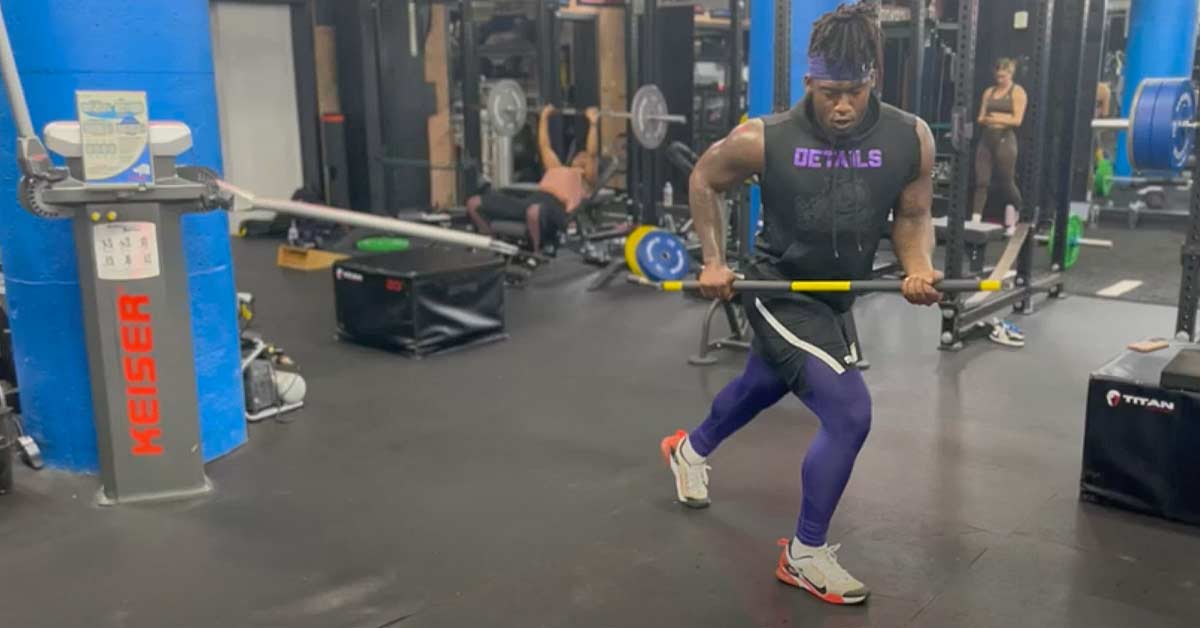The human performance and injury restoration fields are invariably dynamic and rapidly evolving as technology continues to influence our environment. This may be even more evident within the sports sector, where performance and biometric data are becoming more influential for decision-making than ever before.
As a coach or practitioner, there are some fantastic benefits to this hypercompetitive market, as the influx of new tools, technology, and tracking devices provide continuously deeper insight to analyze the human body. But, as we’ve all experienced, not all that shines is gold—for every high-quality product, there are 10 terrible ones. Despite this, as I will cover in this article, we should not be trapped by dogma or dismissive of the value of technology or nuanced equipment in our field.
One innovative company that has become a staple in both strength and conditioning and physical therapy facilities over the last few decades is Keiser.
Keiser is preferential in any given restoration or reconditioning phase. But considering shoulder mechanics, there is even more reason to implement Keiser in your return to play programming. Share on XKeiser equipment utilizes a compressor system to provide pneumatic isotonic resistance. The pneumatic resistance creates a different stimulus when compared to static and even cable or band loading. Primarily, the Keiser provides a smooth resistance type that promotes acceleration throughout the full range of motion. This is a distinct advantage compared to static loading, which has a proverbial deceleration period as you approach the terminal range.
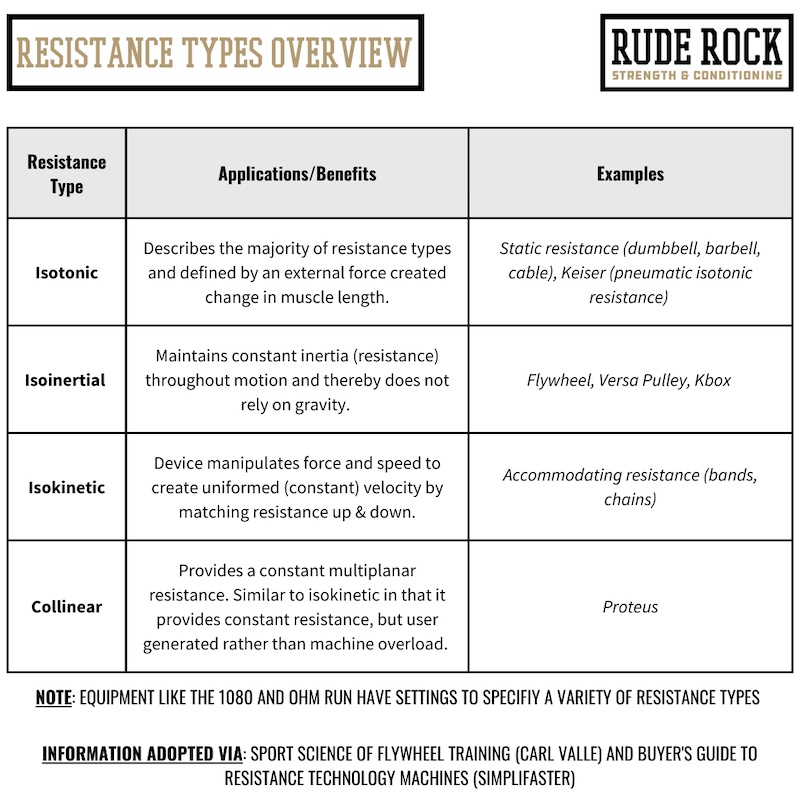
Along with providing a different type of resistance, Keiser equipment allows you to apply a very specific amount of resistance (in increments of around half a pound). The resistance type and specificity can be particularly advantageous for cases of return to play, as the Keiser tends to be more “joint friendly” in a general sense. Another distinction to the Keiser cable is the free motion anchor point, which promotes a favorable mechanical advantage for the athlete by not being confined to a fixed point (fulcrum). The maneuverability of the fulcrum functions similarly to bands or a landmine in that it allows the athlete to slightly manipulate and position their body in a way that de-emphasizes mechanical stress on the joints.
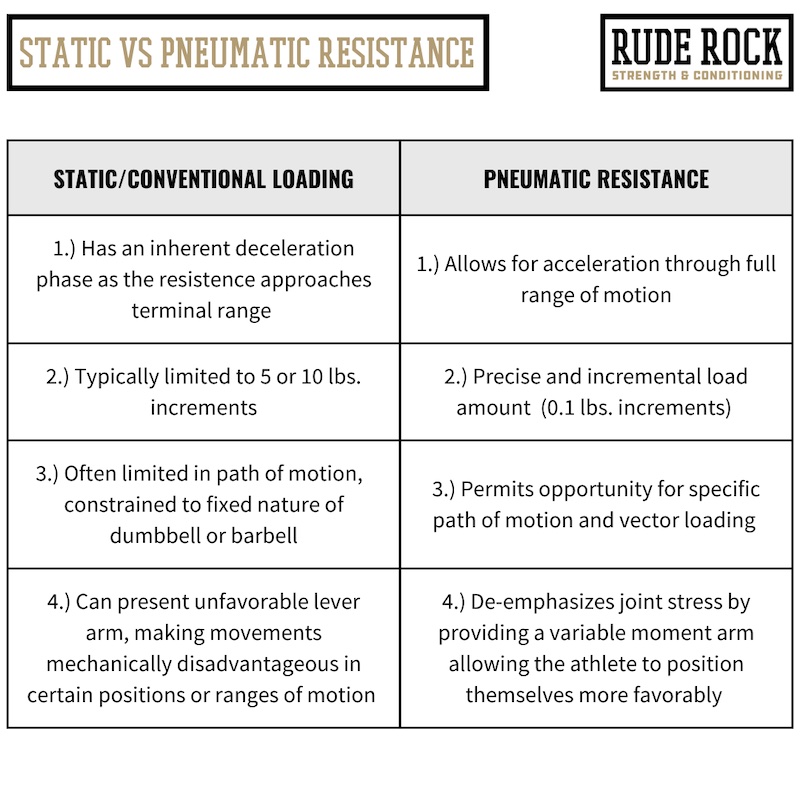
While the Keiser equipment is quite versatile and can be utilized in myriad ways, in this article, I focus specifically on the way I have used Keiser for shoulder restoration. The paragraphs above allude to why the Keiser is preferential in any given restoration or reconditioning phase. But considering the mechanics of the shoulder, I believe there is even more reason to implement Keiser in your return to play programming.
Injury Restoration and RTP
Despite being a strength and conditioning coach, most of my career has been developed around working with injured athletes and return to play concepts. This has created a unique role that has afforded me a specific skill set that is somewhat unconventional for a strength and conditioning coach. Nevertheless, I have always sought out methods, equipment, and applications that are pragmatic for getting athletes back on the field and establishing full health and confidence. Even the most powerful and athletically gifted athletes can have their confidence shattered by sustaining an injury. This fragmented confidence becomes evident as athletes begin to transition back to normal training and are tasked with stressing their bodies again.
From the point of view of a strength coach, we want to take this into consideration when programming and selecting exercises. Most notably, conventional compound movements (i.e., bench press, push press, back squat) often provoke the greatest sense of discomfort or even intimidation. This isn’t to say we need to remove the conventional lifts entirely, but I believe there are preferential options as we initiate this restorative phase—such as the Keiser. Tying this into shoulder restoration specifically, I have found that the Keiser, being generally less imposing than static loading, can enable the athlete to concentrate primarily on performing the work at hand rather than feeling concerned about their injury.
Keys for Shoulder Restoration
Whereas the primary role of the physical therapists, athletic trainers, and other members of the early phase rehab team is largely focused on localized treatment and rehabilitation, I believe the primary role of the strength coach is to reintegrate the injured area into the body. For the shoulder, this starts by emphasizing the core and thoracic spine, which collectively represent the foundation for shoulder health.
Trying to improve shoulder function while neglecting the core is no different from trying to rehab a knee while neglecting foot function, says @danny_ruderock. Share on XTrying to improve shoulder function while neglecting the core is no different from trying to rehab a knee while neglecting foot function. These kinetic relationships are paramount for fully restoring injuries, and the shoulder is no exception to this. Considering the general setup for Keiser exercises, we are able to implement a wide variety of movements that promote this kinetic relationship between the core and the shoulder girdle, as well as the shoulder with the lower arm/wrist.
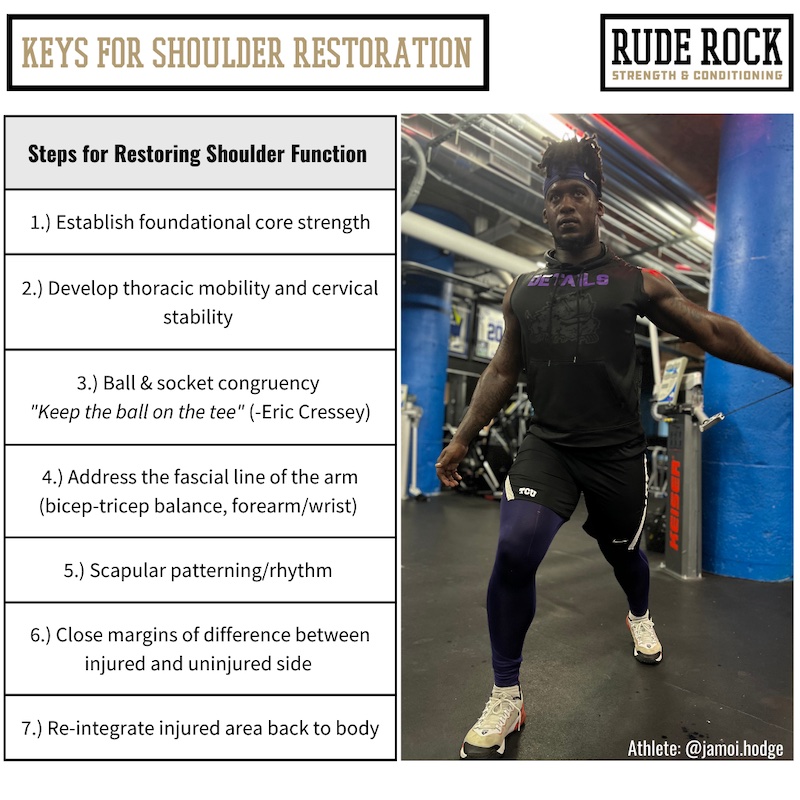
Beyond the core strength and function of the thoracic spine, we want to look to additional kinetic relationships of the shoulder—the fascial arm line, anterior structures (pec muscles, clavicle), and posterior structures, which predominantly include the scapulae. The fascial arm line will be addressed mostly indirectly, but an important consideration here is to provide exercises and movements that permit full ranges of motion.
There is a direct relationship between the inferior joints (i.e., elbow, wrist) and the shoulder. As we seek to restore injured sites, we must put a premium on the positioning of surrounding joints. What you will notice with many conventional movements is compensation at the wrist or lack of extension at the elbow, which are compensations for incomplete shoulder mechanics. For this reason, I prefer to use load types and setups that minimize this, and I see the Keiser as a valuable option for just that.
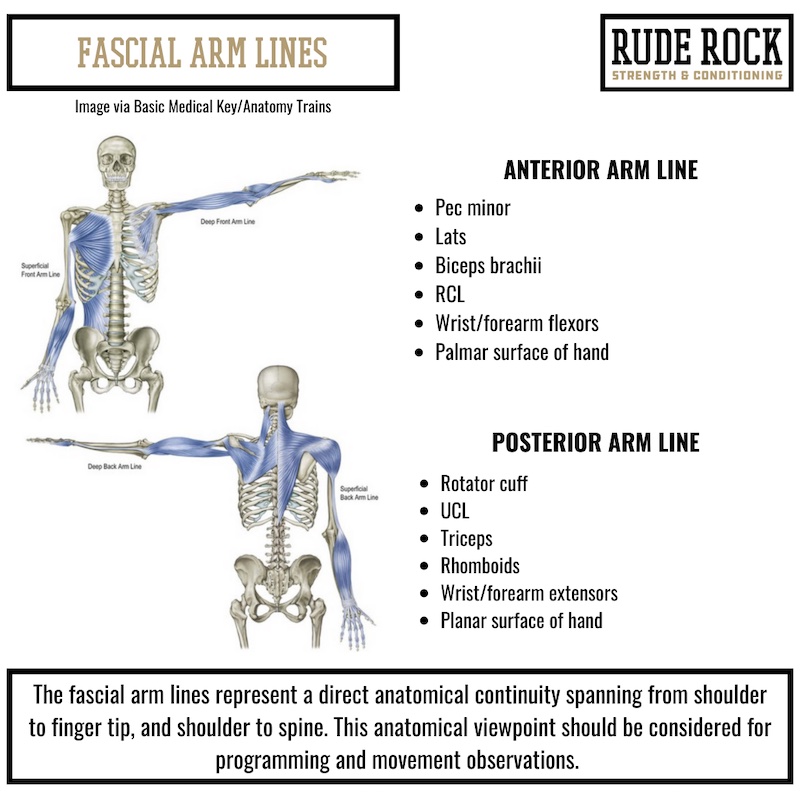
Additional focal points, closing margins of difference, and completely reintegrating the injured area back into the body are largely developed around two points:
When recovering from any extremity injury, shoulder included, there will be obvious decrements in strength and power and muscle atrophy. I am a full believer in mostly unilateral loading, injured or not, but for the case of restoration, I find this to be non-negotiable. We want to stress the body independently in an effort to address these functional differences.
Similarly, the open chain nature, as provided by Keiser movements, is another key element to restoration. Open chain movements help the athlete redevelop the kinesthetic and proprioceptive acuity in a way you don’t typically receive from static loading. When a body part has become dormant due to prolonged immobilization, re-establishing the proprioception and kinesthetic acuity is paramount for the athlete.
Incorporating the Keiser into Your Shoulder Restoration
One of the best elements of the Keiser is the inherent versatility it provides, and this applies not just in the sense of exercise variations but also in the way you can work it into your program. Generally speaking, I get the most use of the Keiser during my accessory blocks, but for the sake of shoulder restoration, I also find ways to work Keiser options into my primary blocks.
One of the best elements of the Keiser is the inherent versatility it provides, and this applies not just in the sense of exercise variations but also in the way you can work it into your program. Share on XTwo examples of using the Keiser in a primary block are a single arm shot put and a low-to-high transfer. I use these types of movements in lieu of contemporary options such as BB/DB chest presses, push presses, or even a landmine press if the athlete is in earlier phases of the RTP timeline. This relates to what we addressed in the opening paragraphs, in that the Keiser allows for acceleration throughout a full range of motion, which is preferable for scapular mechanics.
Video 1. Differences between pneumatic vs. static resistance.
The secondary and accessory blocks are where I really get the most out of the Keiser, and this applies to virtually any athlete I work with. While I love band work as much as anyone, there is a limitation to isolated band loading for some RTP cases with the amount of eccentric tension toward the end range. Conversely, the Keiser can be loaded precisely to allow the athlete a greater range of motion under load. I know that I’ve been preaching total body and integration throughout this article, but there is absolutely a time for isolating areas or muscle groups. Here is a good example of a simple rotator cuff series using the Keiser below.
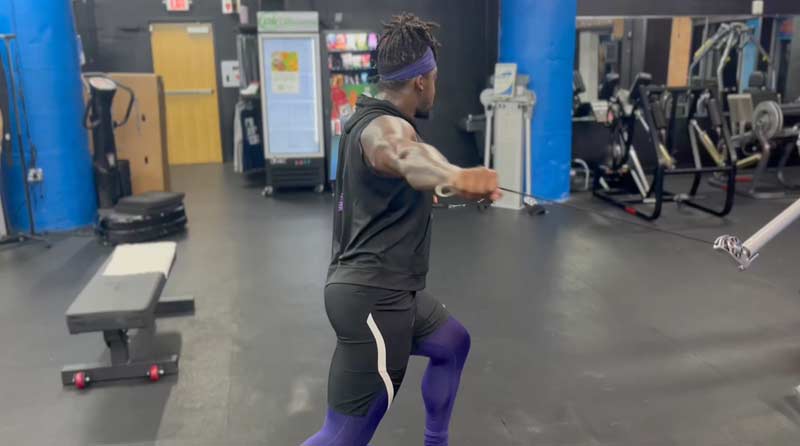
Finally, the value of the Keiser can be demonstrated through the ability to perform rotational and bending patterns, both of which are essential for full shoulder restoration. Incorporating rotation and bending patterns for shoulder health speaks to several points, namely, the importance of core strength and trunk stability. I believe the obliques are a critically neglected muscle group for shoulder health, and that is particularly a foundational piece for overhead or throwing athletes.
There is an array of patterns utilizing the Keiser that directly address the lateral core—a few of my more common selections include the long lever chop, lunge with cross chop, and reciprocating push-pull. True to the theme of kinetic integration, these three also demand rotator cuff activation and glenohumeral stability across multiple vectors, another element of “bang for your buck” movement options.
One Part of Training Prescription
There is a fundamental difference in strength training applications when working in the restorative space as compared to a developmental or more conventional endeavor. Atop these differences, coaches need to recognize the effects of load type and movement parameters and how these impact the joint or tissue in question. While there is plenty of room for interpretation and discourse on optimally loading or training healthy athletes, I believe there is less room for it in restorative cases. Whereas performance outcomes are more driven by production and quantitative values, athlete restoration is guided more by position, function, and feel.
While there is plenty of room for interpretation and discourse on optimally loading or training healthy athletes, I believe there is less room for it in restorative cases, says @danny_ruderock. Share on XFrom the distinct advantages of pneumatic resistance, specificity of load and position, and the open chain and globally integrated nature of Keiser, I believe these qualities offer a preferable option for athletes recovering from injury. As with any specific equipment or training modality, this shouldn’t be seen as a panacea for training outcomes. In other words, as much as I love the Keiser, this should be seen as a part, not an entirety, of training prescription. But as I’ve experienced, the Keiser does represent a good portion of my programming for shoulder restoration cases, and I have seen tremendous outcomes from doing so.
Since you’re here…
…we have a small favor to ask. More people are reading SimpliFaster than ever, and each week we bring you compelling content from coaches, sport scientists, and physiotherapists who are devoted to building better athletes. Please take a moment to share the articles on social media, engage the authors with questions and comments below, and link to articles when appropriate if you have a blog or participate on forums of related topics. — SF

